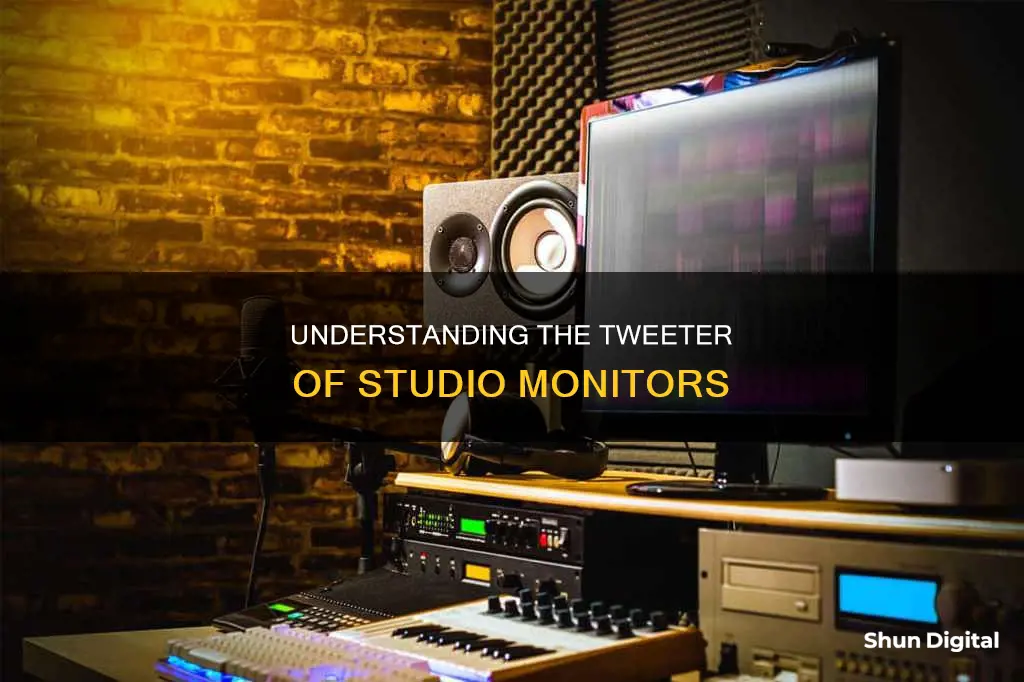
Studio monitors are an essential component of any recording studio, and their design and placement are critical to ensuring an accurate listening experience. The top part of a studio monitor typically consists of a tweeter, a small driver responsible for producing high frequencies, usually above 2 kHz. This tweeter is often cone- or dome-shaped and is placed above a larger driver called a woofer, which handles low and mid-range frequencies. Together, these drivers aim to reproduce a flat frequency response, making studio monitors ideal for critical listening and identifying sonic imperfections during the recording, mixing, and mastering process.
| Characteristics | Values |
|---|---|
| Name | Tweeter |
| Description | The tweeter is the top part of a studio monitor that produces high frequencies. |
| Shape | Cone-shaped or dome-shaped |
| Frequency Range | Usually starting at around 2 kHz |
| Positioning | Should be at ear level with the listener |

The tweeter
The placement of the tweeter is crucial to achieving optimal sound quality. It is recommended that the tweeter be positioned at ear level to allow for a more accurate discernment of high-end frequencies. This can be achieved through the use of angling stands or monitor stands that raise the studio monitors to the appropriate height. Additionally, the tweeter should be angled towards the listener at an angle of around 30 degrees, forming an equilateral triangle with the listener's head. This ensures that the high-frequency sounds are directed at the listener's ears, providing a clear and immediate impression of the mix.
The performance of the tweeter can be further enhanced by ensuring adequate distance between the studio monitors and nearby walls. A minimum distance of 20 to 30 cm is recommended to reduce sound reflections that can interfere with the listening experience. Additionally, the distance between the monitors and the side and back walls should be different to avoid creating corners that can affect sound quality.
Monitoring Staff Internet Usage: Strategies for Effective Oversight
You may want to see also

The woofer
The placement of the woofer is important for optimal sound. In most cases, the centre of the tweeter should be at ear level, allowing for a more accurate perception of high-end frequencies. However, if this is not feasible due to space constraints or monitor placement, angling stands can be used to raise the monitors and direct the sound towards the listener.
Additionally, it is recommended to avoid placing monitors directly on hard surfaces, as this can cause unwanted reflections and vibrations. Monitor stands or isolation pads can help mitigate these issues and ensure a clearer, more balanced audio output.
Monitoring Employee Internet Usage: Privacy at Home?
You may want to see also

Active vs passive monitors
Studio monitors are speakers used in recording studios, radio stations, and other professional audio settings to mix music, dialogue, and sound effects. They are designed to have a flat frequency response, meaning that all frequencies are played at the same volume level. This is crucial for accurately balancing the levels of different frequencies during the mixing process.
Now, when it comes to active vs passive studio monitors, here are the key differences and considerations:
Active Studio Monitors
Active studio monitors have built-in amplifiers, making them simple to set up and use. They don't require any additional equipment, such as external amplifiers or cables, and can be directly connected to an audio source. The built-in amplifiers are specifically designed and tuned for the monitors, often resulting in better overall sound quality. Active monitors are also more convenient and widely used, with advancements in Class-D power amp design and digital signal processing integration.
Passive Studio Monitors
Passive studio monitors, on the other hand, do not have built-in amplifiers. They require external amplifiers to function and offer more flexibility in terms of upgrading and customisation. With passive monitors, you can choose and pair the speakers with external amplifiers that best suit your needs. This allows for a more gradual and cost-effective progression to higher-quality gear. Additionally, passive monitoring systems are modular, giving you the freedom to match your speakers with appropriate amplifiers and crossovers.
Factors to Consider
When deciding between active and passive studio monitors, consider your specific needs, preferences, and budget. If you prioritise ease of use and want a reliable, accurate, and plug-and-play solution, active monitors are a good choice. On the other hand, if you're willing to put in some extra effort and value flexibility, passive monitors might be preferable.
It's also important to consider the quality of the power amps and power supplies in active monitors, especially at the budget end of the market. In some cases, passive monitors with high-quality external amplifiers can provide better sound quality than poorly designed active monitors.
Both active and passive studio monitors have their advantages. Active monitors offer convenience and performance, while passive monitors provide flexibility and upgradeability. The choice ultimately depends on your specific requirements and budget.
Is Your Monitor Too Bright? Check with These Tips
You may want to see also

Amplifiers
Passive monitors require an external amplifier to amplify the input signal before it enters the monitor. The amplified signal then passes through a crossover network, which acts as a filter, separating the signal into multiple signals based on frequency. This ensures that the correct frequencies are sent to the appropriate drivers (speakers). In a two-way monitor with a tweeter and a woofer, the crossover network will create two signals – one with higher frequencies for the tweeter and one with lower frequencies for the woofer.
On the other hand, active monitors have built-in amplifiers housed within the cabinet. The input signal first passes through the crossover network and is then amplified separately for each frequency band before being sent to the relevant drivers. This configuration is known as a "bi-amp" system. Active monitors are more convenient for home studio setups as they eliminate the need for external amplifiers and simplify the calibration process.
For both passive and active monitors, amplifier configurations play a significant role in the overall sound quality. The single-amp configuration is the simplest, where a single amplifier powers both the left and right speakers. This setup is rarely used in studio monitors but is common in computer speakers.
The bi-amp configuration, as discussed earlier, provides greater control over the frequency response and more precise sound reproduction. Each driver in a two-way design has its own dedicated amplifier, allowing for better frequency separation and improved audio clarity.
Taking it a step further is the tri-amp configuration, typically found in high-end professional studios. In this setup, each driver in a three-way speaker system (woofer, midrange, and tweeter) has its own dedicated amplifier, providing ultimate control over the frequency response and enabling the most precise sound reproduction.
When choosing between passive and active monitors, it's important to consider your specific needs and budget. While active monitors offer convenience and are widely used by professionals, passive monitors provide more flexibility in amplifier selection and are often favoured by those seeking customisation options.
In conclusion, amplifiers are a critical aspect of studio monitors, and selecting the appropriate amplifier configuration is essential for achieving the desired sound quality and precision in your audio setup.
Studio Monitor Hookups: Multiple Devices, One Speaker
You may want to see also

Monitor placement
The placement of studio monitors is critical to achieving the best sound quality and accuracy. Here are some guidelines and tips for optimal monitor placement:
- Symmetry is Important: Place your monitors symmetrically in the room, preferably along the shortest wall to minimise sonic reflections.
- Listening Position: Identify the "sweet spot" in the room, which is usually centred between the sidewalls to achieve a balanced stereo image. Avoid sitting in the exact centre of the room, as this is where the room's fundamental frequency or its harmonics create a "null".
- Monitor Height: Position the tweeters of your monitors at ear level, ensuring that your ears are directly in front of the speakers. This provides the most consistent sound. If necessary, use speaker stands to elevate the monitors.
- Avoid Reflections: Prevent early reflections by placing the monitors behind the console or desktop on decoupled stands. If they must be placed on the desktop, use foam blocks to minimise coupling with the desk.
- Angle and Distance: For accurate stereo imaging, position the monitors at a 30-degree angle towards the listening position, forming an equilateral triangle. Maintain a distance of three to five feet between the monitors and the listening position for "nearfield" monitoring.
- Speaker Orientation: Ensure the monitors are aimed directly at your ears. You can tilt the speakers slightly if necessary.
- Avoid Multiples: When positioning speakers, avoid exact multiples of distances to walls and ceilings to minimise the undesirable effects of room modes.
- Acoustic Treatment: Use acoustic foam or similar materials to treat reflective surfaces and minimise flutter echoes. Treat sidewalls, the ceiling if it's low, and the area behind the monitors if they are close to the wall.
- Listening Tests: Use familiar, professionally recorded music to verify the accuracy of your monitor placement and make any necessary adjustments.
Identify Your Monitor Model: A Quick Guide to Knowing Your Screen
You may want to see also
Frequently asked questions
The top part of a studio monitor is called the tweeter.
A tweeter is responsible for producing high frequencies, usually starting at around 2 kHz.
Tweeters are often cone- or dome-shaped, constructed from a wide range of materials.
It is recommended that the centre of the tweeters be at the listener's ear level, as this will help discern what is happening at the higher end of the frequency spectrum.
Yes, there are different types of tweeters available, such as "outy" and "inny" tweeters. "Outy" tweeters are usually convex and dome-shaped, while "inny" tweeters are concave and cone-shaped.







